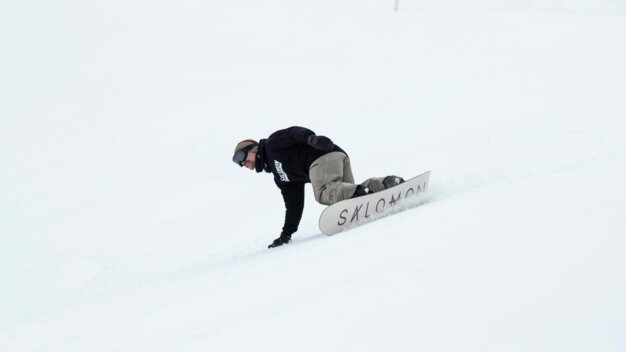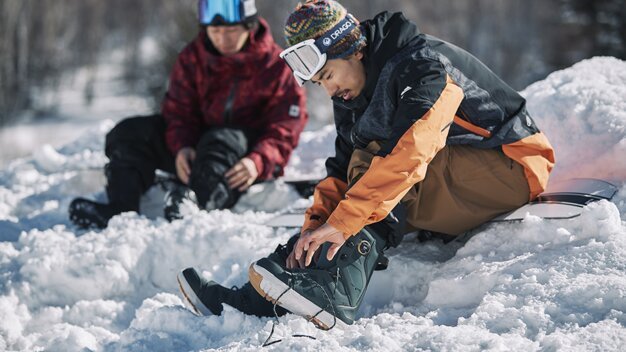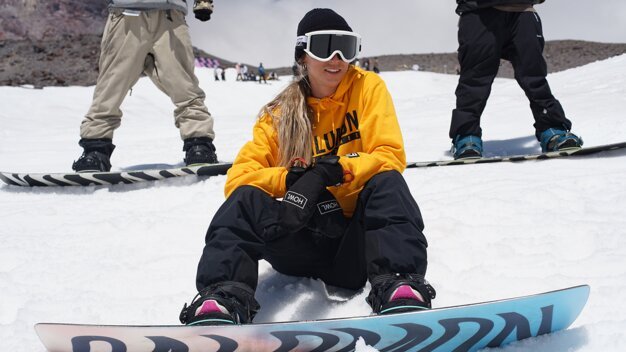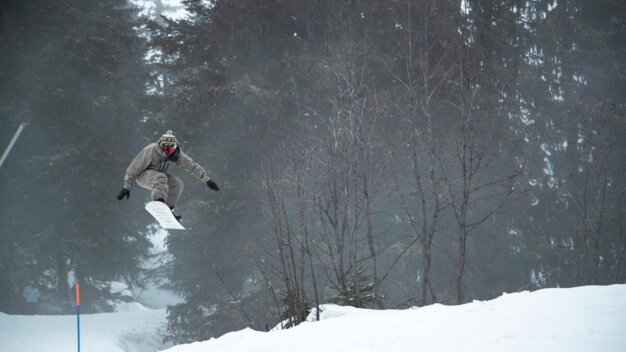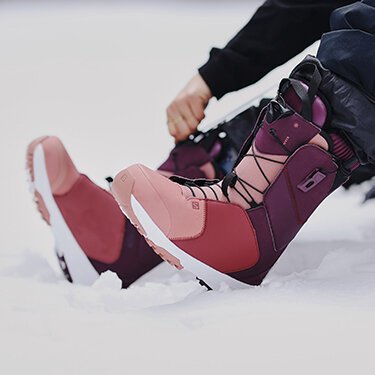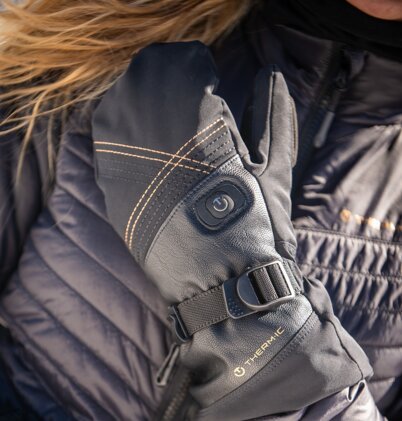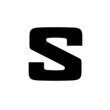
Have you just discovered your love of snowboarding? Welcome to the club - you can look forward to some first-class adventures in the snow - whether on the slopes, in the park or off-piste! However, choosing your first snowboard can be a real challenge. Especially at the beginning, you don't have the experience to assess what features your first snowboard should have. Also, many of the terms are anything but self-explanatory.
To make things easier for you, INTERSPORT Rent and Salomon present you with a buying guide for beginner snowboards, in which we explain the different types, lengths and profile shapes of the boards. In this context, we also clarify for which purposes they are suitable.
Snowboarding for the first time: Here's what you should think about
A high-quality snowboard is not a cheap purchase. So, consider what you really need before you spend your hard-earned money on it. The first question you should ask yourself is: What are you going to use your snowboard for - the park, the slopes, the backcountry or a bit of everything? If you are clear about this, it will make your decision a lot easier.
There are these types of snowboards
Whether you are a beginner or an advanced snowboarder, the question of which type of snowboard to buy is one of the fundamental decisions when making a purchase. This is because each type of snowboard offers advantages and disadvantages for certain areas of use:
Alpine snowboards for the slopes:
Snowboards for carving in the ski resorts are specially designed to deliver maximum performance on groomed slopes. These boards are characterised by a camber profile, which ensures excellent edge grip, powerful turns and precise handling. Most of them have a stiff to medium flex, which favours stability and direct power transmission. The shape, usually directional or directional twin, supports directional stability and provides additional control on hard snow.
Advantages:
- Precise turn initiation thanks to camber profile
- Hard to medium flex enables higher speeds on groomed slopes
Disadvantages:
- The higher the flex, the less forgiving of riding mistakes
All-mountain snowboards
All-mountain snowboards are versatile all-rounders that are suitable for any terrain - whether slopes, powder or park. With a medium flex and a balanced shape, they offer stability, manoeuvrability and riding fun for beginners and advanced riders who want to be flexible on the whole mountain.
Advantages:
- For different areas of use
- Suitable for almost all skill levels
- Medium flex is forgiving
Disadvantages:
- Not the best choice if you want to specialise in one discipline
Freeride snowboards
Freeride snowboards are characterised by a special shape that makes riding in deep snow particularly easy. Typical features are a wider, often longer nose and a shorter, narrower tail. Combined with an offset binding position (setback), this design provides more flotation in powder. Many freeride boards also have a prominent torsional rigidity and are made of robust material, which gives them stability and control even at high speeds and in demanding terrain. Thanks to their directional or tapered shape, they are ideal for fast, straight descents and precise manoeuvring in the backcountry.
Advantages:
- Lots of flotation in deep snow
- Stable at high speed
- Suitable for advanced and professional Riders
Disadvantages:
- Start to flutter on the slopes at higher speeds
- One-sided intended use
Freestyle snowboards
Freestyle snowboards are characterised by their symmetrical shape, where the nose and tail are the same length and shape. This allows you to ride the board both forwards and backwards (switch). Another typical feature of freestyle boards is a soft to medium flex, which ensures maximum turning ability and is more forgiving of riding mistakes. They are often shorter and lighter in order to remain manoeuvrable in the air and enable playful control.
Advantages:
- Ideal for jumps and rails
- Suitable for creative snowboarding
Disadvantages:
- Unstable at high speeds
If you are unsure about which board is the right one for your purposes, we recommend a consultation with our RENTertainers at an INTERSPORT Rent shop near you. Benefit from our rental service by testing different types of snowboards before you buy your own.
The right profile for your first snowboard
The profile of your snowboard is one of the most important aspects when choosing a beginner snowboard. This refers to the curve of the board between the two points of contact with the snow.
Snowboards with traditional camber
Boards with a traditional camber only have two points of contact when you look at them from the side. The area in between is curved upwards.
Purpose: slope and park
Characteristics:
- Power and precision
- Stability: Stable
- pop
- control
- liveliness
Snowboards with reverse camber and rocker
Snowboards with this side cut have a banana shape on the side and, depending on the extend of the shape, only one central contact point that extends to different lengths. The rocker profile is also known as concave camber.
Purpose: Freeriding
Characteristics:
- Forgives more mistakes
- Offers more float in deep snow
- Makes turn initiation easier
Did you know? There are also hybrid boards that combine the advantages of various profiles.
Snowboards with a flat camber/rocker
Snowboards with this shape have a single contact point over the entire edge length.
Purpose: slope and park
Characteristics:
- Stable at high speeds
- Very good edge hold
- High playfulness
Our tip: The best snowboard profiles in terms of stability and turn initiation (two of the most important factors for beginners) have a flat camber/rocker profile, a rocker or are hybrids of the before mentioned shapes. Their construction enables good handling without demanding too much strength and experience from the rider.
What is the effective edge and the sidecut radius?
The effective edge length refers to the part of the edge that’s touching the snow during a turn. The length is significantly influenced by the profile of the snowboard.
In general, it can be said that ...
- ... a short effective edge is more manoeuvrable.
- ... a long effective edge offers more stability.
As far as the sidecut radius determines: A larger radius is ideal for longer, sweeping turns, while the opposite allows compact, quick changes of direction.
Choose the right shape for your first snowboard
When buying a snowboard, you also have the choice between different shapes and forms:
Directional
A directional snowboard is designed to be ridden particularly well in one direction. Depending on the area of use, it has a longer and/or wider nose and a shorter, often stiffer tail. The binding is usually offset to the rear to provide more flotation in deep snow and better control at higher speeds.
Area of use: depending on the profile, for slopes or off-piste riding
Features:
- Nose longer than tail
- Tail usually more angular
- Designed for high speeds on the slopes or off-piste
True Twin
A true twin shape is symmetrical so that the nose and tail are identical and the bindings are mounted in the centre.
Area of use: park and slope
Characteristics:
- Nose and tail exactly the same length
- Facilitate switch riding
- Ideal for tricks on rails and jumps
Directional Twin
A directional twin shape snowboard has a symmetrical shape with identical nose and tail. However, the bindings are offset slightly backwards (towards the tail), which gives the board more stability and flotation when riding forwards.
Area of use: slope and freeriding
Characteristics:
- Directional, but similar to a twin
- Offers advantages of both shapes
- Lots of flexibility in the terrain and on the slopes
Our tip: True Twin snowboards are ideal for beginners. Their symmetrical shape makes it easier to keep your balance. They also suit almost all riding styles.
The right snowboard length and width
The length of your board is another important factor. It has a significant influence on riding behaviour, whereby boards that are too long or too short have advantages and disadvantages. When buying, make sure that the size of your board suits your level and style.
Advantages and disadvantages of long snowboards:
Advantages:
- More stable at higher speeds
- Better flotation in deep snow
Disadvantages:
- More effort required for turn initiation
- Harder to rotate during tricks
- Forgive fewer mistakes
Advantages and disadvantages of short snowboards:
Advantages
- More forgiving of riding errors
- Lower swing weight during spins and turns
Disadvantages:
- More unstable at high speeds
Our tip: As a beginner, you should choose a slightly shorter board than the standard all-mountain length. The basic recommendation is 5 to 10 cm less than your height. However, bear in mind that aspects such as your physique can also play a role. If you are unsure, our experts at an INTERSPORT Rent shop will be happy to help you. We look forward to your visit.
Choosing the right snowboard width
The waist width indicates the width of a snowboard at its narrowest point. Most boards have a standard width - but this can often be too narrow for riders with larger feet. Beginners in particular tend to start with narrower models because they allow for better edge control.
Our tip: Your boots should normally stand one to two centimetres over the edge.
This is how important flex is for snowboards
The degree of rigidity or flex of a snowboard has a major influence on riding comfort. The stiffness of the board is decisive for the following characteristics:
- Responsiveness
- Edge hold
- Pop
- Flotation
- How forgiving a board is
Many boards have a dynamic flex. This means that the different areas of the snowboard have different flex.
In general, it can be said that a softer flex is more forgiving of riding mistakes, while a harder flex offers more responsiveness. A softer board is therefore particularly suitable for beginners, as you will make faster progress.
Frequently asked questions about choosing your first snowboard
Is it easy to ride a snowboard for the first time?
Getting into snowboarding can be challenging at first, as balance and coordination have to be learnt. Braking and cornering in particular require some practice. Added to this is the unfamiliar body position, as - unlike skiing - you are standing sideways. Nevertheless, with the right equipment and a snowboard course, quick success is possible.
Are all-mountain snowboards good for beginners?
All-mountain snowboards are generally a good choice for beginners, as they cover a wide range of uses. If you are not yet sure whether you prefer to ride on the slopes, in the park or off-piste, these all-rounders are worth investing in. What's more, the flex of the boards is usually not too hard, which means they are forgiving of small riding mistakes.
Thanks to our rental options, you have the chance of testing different boards before deciding whether or not to buy. Visit us at a shop near you and let our RENTertainers advise you.
Which is better camber or rocker?
A snowboard with a camber profile offers maximum precision, stability and edge hold. It is perfect for high speeds on hard slopes and enables precise carving turns. This design is the right choice for advanced and ambitious riders who value control and responsive performance.
The rocker snowboard, on the other hand, scores with significantly more forgiving handling, high manoeuvrability and more float in powder. Especially in deep snow, on soft ground and for freestyle use, you can enjoy a flowing ride thanks to the curved nose.
At what age should you start learning to snowboard?
The ideal start to snowboarding for most children is between the ages of six and seven - with the right equipment, patience, the right snowboard course and the joy of learning together, the first snowboarding experience is guaranteed to be unforgettable. Generally speaking, you're never too old to learn something new!
INTERSPORT Rent tip
The RENTertainer recommends
Still not quite sure what to look for when buying a snowboard? No need to despair! Our RENTertainers in the ski resorts are experienced winter sports experts. They know all about length, camber and flex and will help you find the perfect board for your needs.
The advantage: thanks to our high-quality rental equipment, you can try out different boards before deciding on your favourite!
Related articles
You may also be interested in:
